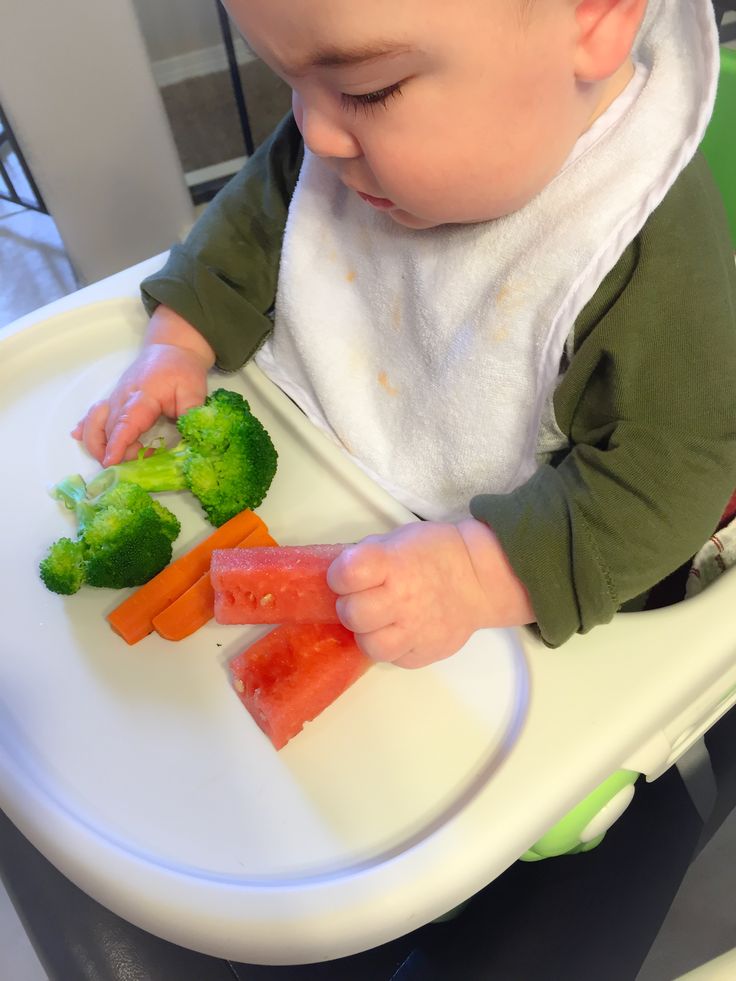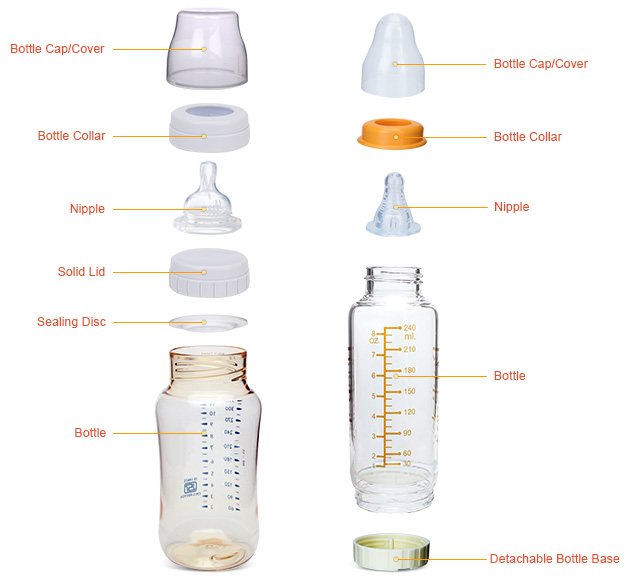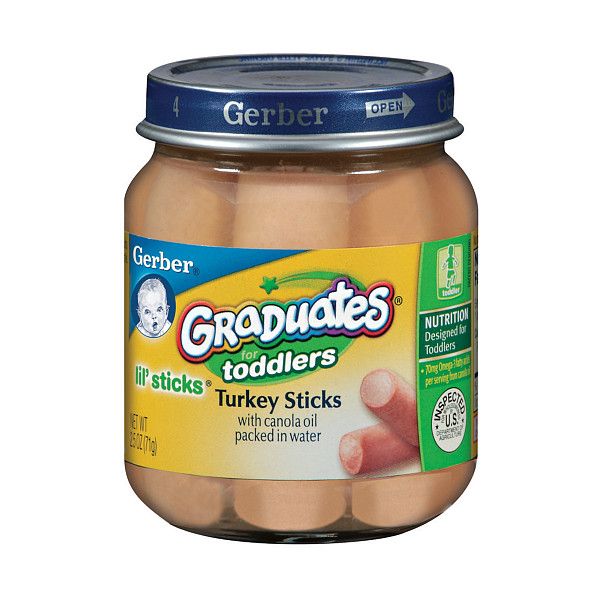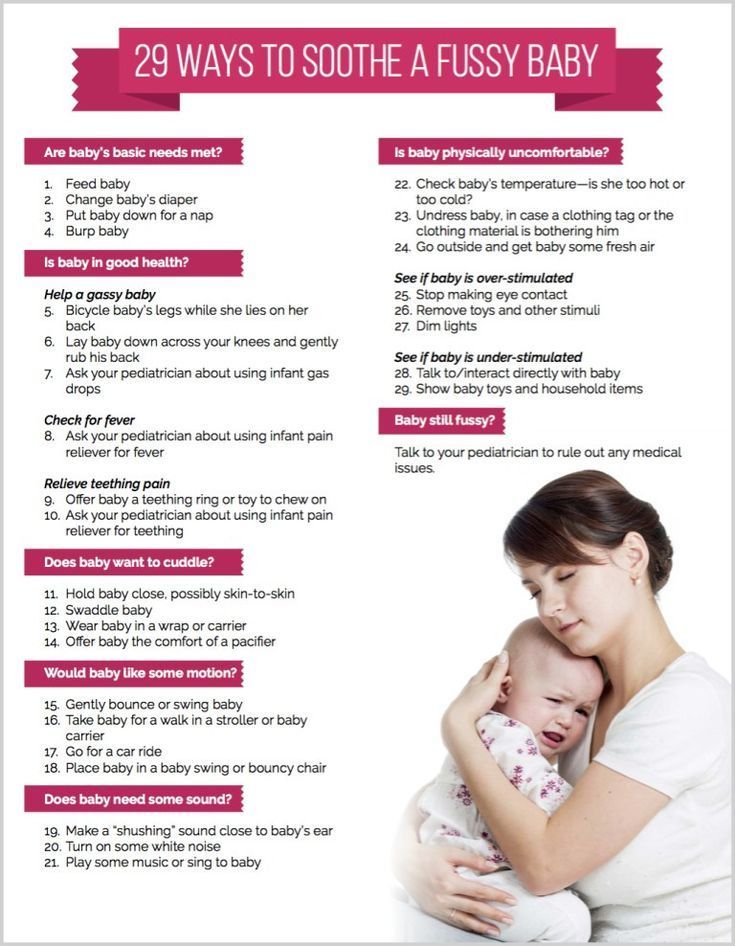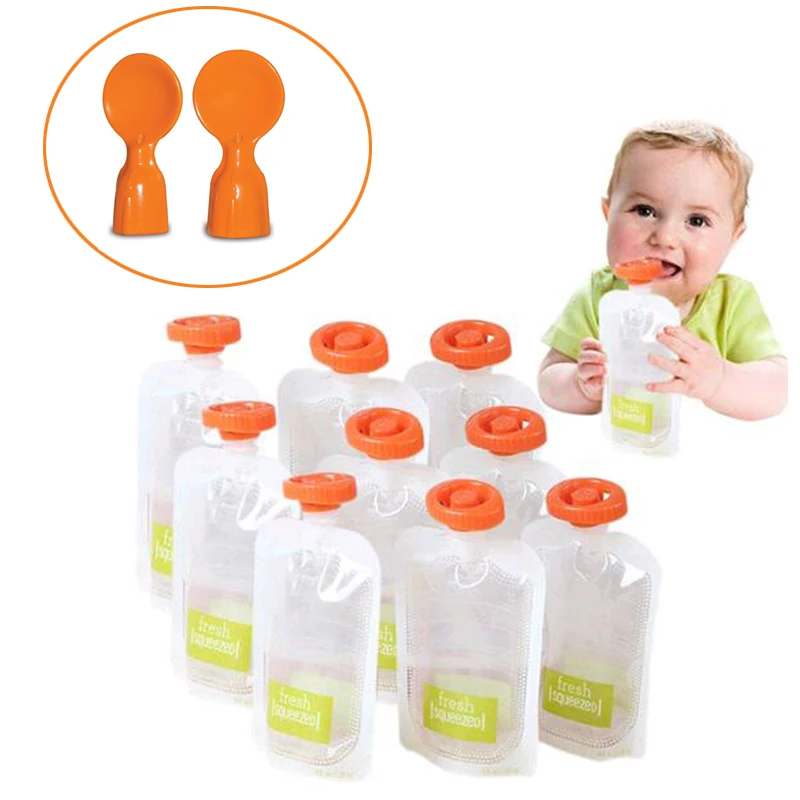Baby lead weaning food
11 Foods for Baby-Led Weaning and What Foods to Avoid
Around 6 months of age, babies get to spark their taste buds by adding foods to their otherwise breast milk- or formula-based diet. Many caregivers look forward to the opportunity to watch their babies respond to a variety of new colors, textures, and flavors.
Babies may be spoon-fed infant purees, the typical approach in Western society, or they may feed via the baby-led weaning (BLW) method.
BLW is characterized by infants feeding themselves small pieces of soft foods they can pick up independently. Proponents of this method claim that it offers benefits such as improved appetite regulation and motor skills (1).
This article presents the best and worst baby-led weaning foods.
Avocados are fruits known for being highly nutritious. They are an ideal food for babies and adults alike. It’s no secret that babies grow rapidly in the first year of life and need adequate nutrition to support this.
This easily mashable fruit is typically famed for its healthy fat content, but it’s also packed with fiber, potassium, folate, copper, and vitamin E (2).
Only 5% of Americans meet their adequate intake (AI) for daily fiber. This nutrient is known to enhance digestion and help reduce the risk of certain chronic diseases, including cancer, diabetes, and heart disease (3).
In a study in young children, those with high fiber intakes also had greater intakes of key brain-boosting nutrients for babies, including iron, folate, and vitamin B6. So, feeding your baby avocado and other fiber-rich foods will provide them with many beneficial nutrients (4).
- 6–8-month-olds: Cut a ripe avocado into slices about the width of an adult finger for easy gripping.
- 9–12-month-olds: Cut a ripe avocado into small cubes or chunks.
Though it’s not necessarily a mess-free option for your baby, yogurt is a taste bud-friendly food with calcium, protein, and gut health benefits. Yogurt is a cultured dairy product, meaning that it contains healthy probiotic bacteria cultures such as Lactobacillus (5).
Probiotics play a prominent role in digestive health and can benefit young children who experience tummy troubles such as diarrhea and constipation (6, 7).
For example, in a 2019 study of 82,485 Japanese infants, researchers found that eating yogurt at least 3 times weekly significantly lowered the risk of stomach inflammation (8).
Whole milk yogurt comes in a variety of flavors that might be sweetened with added sugars. The Dietary Guidelines for Americans 2020–2025 recommend that children under age 2 avoid added sugars (9).
The American Heart Association also discourages added sugars in young children because increased added sugar intake may increase heart disease risks by elevating blood pressure and triglycerides (10, 11).
Therefore, the better option for infants is unsweetened whole milk yogurt.
Not only are they affordable and easy to prep, but eggs are also chock-full of nutrients such as protein, vitamins D and A, and choline. In fact, eggs are one of the top sources of dietary choline, which is essential for the development of babies’ brains and eyes (12).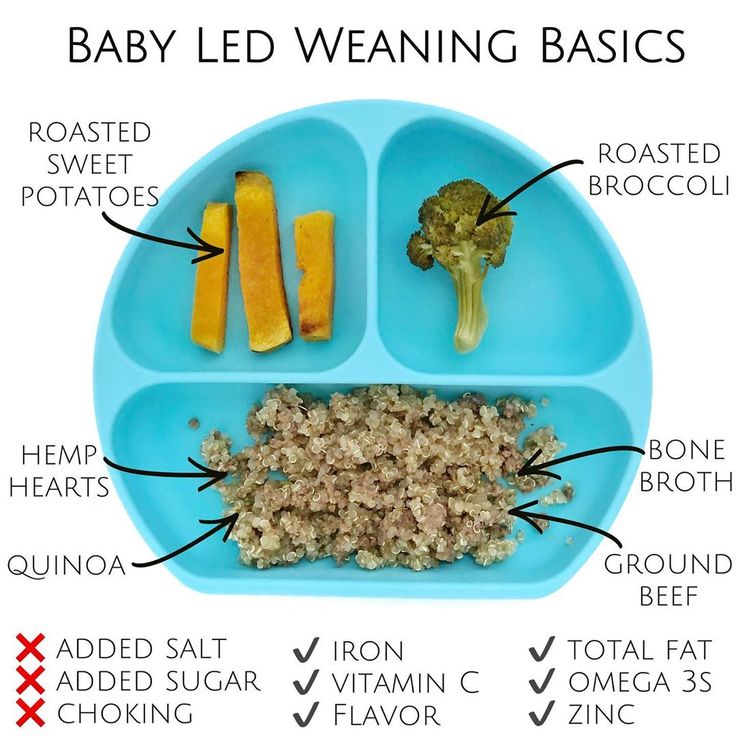
Studies show choline levels are positively aligned with academic achievement in children and information processing speed in babies (12, 13).
Keep in mind that it’s critical to offer only fully cooked eggs to babies to reduce the risk of food poisoning from Salmonella exposure.
Salmonella is a bacteria found in many foods, including eggs, that can cause sickness if the contaminated food isn’t properly cooked before eating. Babies are at high risk of food poisoning symptoms because of their naturally weak immune systems (14).
You can tell that an egg is hard-boiled and safe for your baby if it’s cooked until both the yellow and white parts of the egg are firm (15).
- 6–8-month-olds: Bring water to a boil and hard-boil eggs for 15 minutes. Cut the egg into quarters or strips.
- 9–12-month-olds: Bring water to a boil and hard-boil eggs for 15 minutes. Dice the egg. You can also scramble an egg and cut it into small pieces.

Carrots come in many colors, including orange, yellow, and purple, with each color offering unique nutrients.
Carotenoids are a type of nutrient that is converted into vitamin A in the body. As such, carrots offer babies vitamin A, an essential vitamin for keeping the immune system in good shape (16, 17).
Specifically, lutein is a carotenoid found in carrots. It helps with vision and may contribute to brain growth (18, 19).
- 6–8-month-olds: Peel and cut carrots into sticks about the width of an adult finger. Steam or boil the carrot sticks until soft.
- 9–12-month-olds: Peel and chop carrots. Steam or boil until soft.
Tofu is a calcium-rich, soft, plant-based food that’s an excellent option for babies.
A single slice of tofu offers 10% of your baby’s Daily Value of calcium. Babies rely on this mineral to develop and maintain healthy bones (20, 21).
- 6–8-month-olds: Follow package instructions to squeeze out excess water.
 Cut into wide sticks your baby can grip. Warm the sticks by placing them in the microwave for 10 seconds, or lightly pan-fry to make them lightly crisp for gripping.
Cut into wide sticks your baby can grip. Warm the sticks by placing them in the microwave for 10 seconds, or lightly pan-fry to make them lightly crisp for gripping. - 9–12-month-olds: Follow package instructions to squeeze out excess water. Cut into bite-size cubes your baby can pick up. Warm the cubes by placing them in the microwave for 10 seconds, or lightly pan-fry them.
Some parents worry about giving meat and fish to babies and consider delaying introduction of these foods. However, rest assured that babies can gain a ton of nutritional benefits from these protein-rich foods.
Meat and fish are important for babies, offering essential nutrients for growth and development, including easily absorbable iron, vitamin A, vitamins B6 and B12, and zinc (22, 23).
Because BLW may lead to lower iron intake, parents using BLW are encouraged to add foods rich in iron to every meal (22, 23).
Other iron sources include lentils, spinach, and fortified breakfast cereals (24).
Zinc plays a significant role in brain function, nerve development, and memory. Older babies are at a higher risk of zinc deficiency because their zinc needs increase as they age (25).
Meat and fish are primary sources of zinc. If your family follows a vegetarian diet, oatmeal, ground chia seeds, and brown rice are other sources of zinc for older babies (26).
- 6–8-month-olds: Offer fully cooked, soft, finely shredded chicken, turkey, beef, salmon, or pork.
- 9–12-month-olds: Offer fully cooked shredded or ground meat or small pieces of salmon.
Babies fed BLW-style can eat apples to help meet their needs for vitamin C.
Vitamin C-rich foods can help babies’ bodies absorb iron from iron-containing foods. Further, if infants don’t get enough vitamin C in their diets, they’re at risk of connective tissue problems from a condition called scurvy (27, 28,29).
- 6–8-month-olds: Peel, cut into wedges, and cook apples until soft.
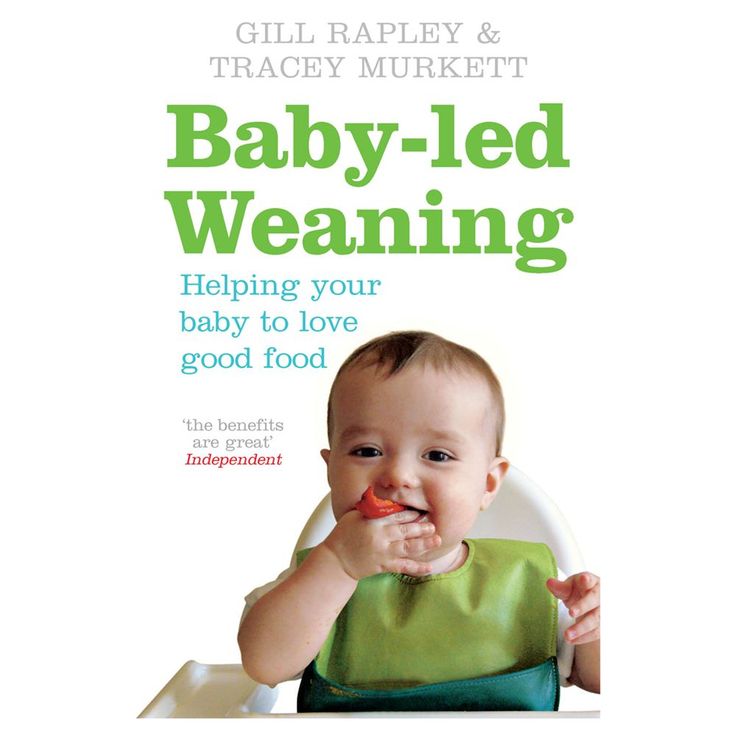 Sprinkle with a pinch of cinnamon.
Sprinkle with a pinch of cinnamon. - 9–12-month-olds: Offer your older baby peeled, shredded raw apples.
A popular root vegetable, sweet potatoes are a well-liked baby-friendly food that’s easy to prepare.
Sweet potatoes contain fiber, a necessary nutrient for healthy digestion. In fact, a low fiber intake is associated with constipation, so sweet potatoes may help keep your baby comfortably regular (30, 31).
- 6–8-month-olds: Cook a whole sweet potato. Peel and cut into strips the width of an adult finger.
- 9–12-month-olds: Cook a whole sweet potato. Peel and cut into small chunks your baby can pick up.
Share on PinterestMaaHoo Studio/Stocksy United
Oats are a whole grain rich in fiber, copper, selenium, zinc, and many other nutrients crucial for immune function and gut health. Babies typically take well to cereal grains such as oats because of their texture, mild taste, and ease of eating (32, 33).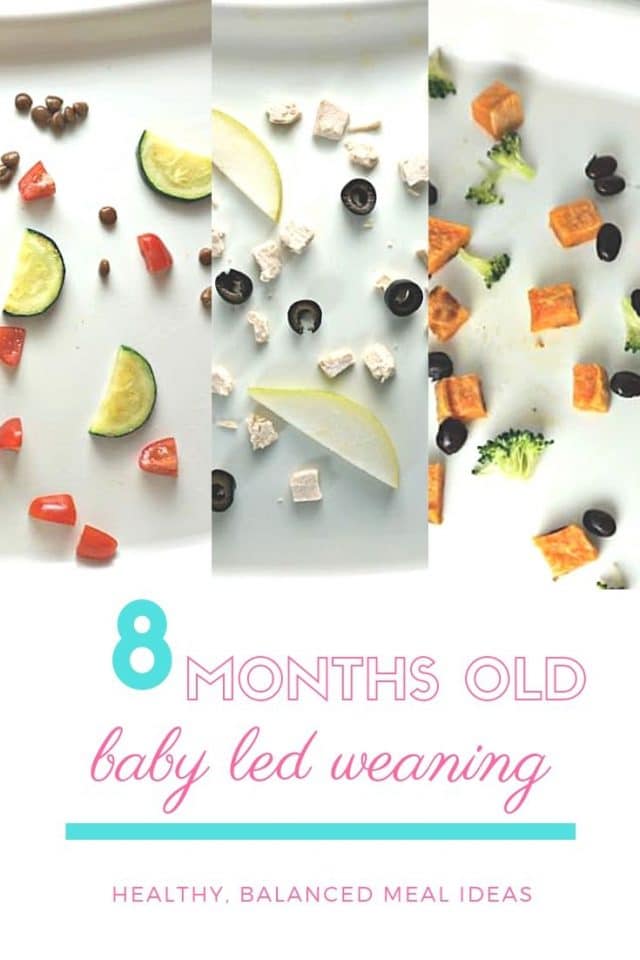
- 6–8-month-olds: Use breast milk or iron-fortified cereal to make baby oatmeal. To serve oats cold, blend or grind them and mix with unsweetened yogurt or applesauce.
- 9–12-month-olds: Make homemade oat muffins and cut into bite-size pieces.
The American Academy of Pediatrics (AAP) encourages offering potential allergen foods, such as peanuts and tree nuts, in infancy. Early exposure to potential food allergens may reduce food allergy risks in babies who are at least 4 months old (34).
Nut butters, such as peanut, almond, and cashew butter, are rich in protein and effortlessly combine with many other foods. Babies must get adequate protein in their diets to support growing bones and muscle strength (35, 36).
Choose a natural peanut butter to avoid hydrogenated oils and added sugars that tend to be less healthy.
Monitor your baby for potential food allergy symptoms such as (37):
- wheezing
- nausea
- hives
- vomiting
- diarrhea
If you suspect your infant may have a food allergy, seek medical help immediately.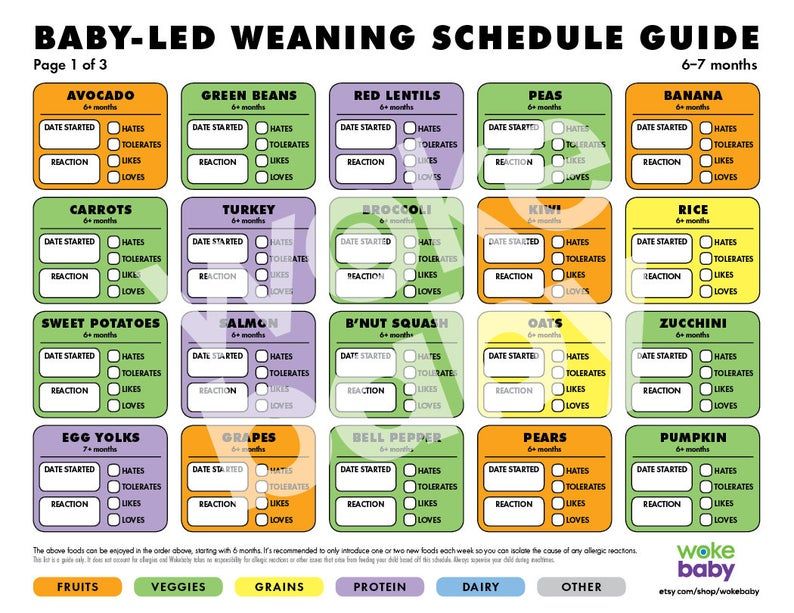
- 6–8-month-olds: Mix a small amount of natural creamy nut butter into yogurt or oatmeal. To reduce the risk of choking, avoid using crunchy nut butter.
- 9–12-month-olds: Spread a thin layer of creamy nut butter onto a piece of toast or a cracker. To reduce the risk of choking, avoid using crunchy nut butter.
Even when your baby is trying new foods, it’s important to also give them plenty of liquid to keep them nourished and hydrated.
Breast milk remains the best source of nutrition for babies. If breast milk is not available, iron-fortified formula is the best alternative nutrition source to ensure healthy growth and development. Babies need breast milk or formula from birth to around 12 months of age (38).
In addition, babies who are at least 6 months old can safely drink 4–8 ounces of plain water daily, according to the AAP (39).
SummarySafe BLW foods for your baby include cooked eggs, oats, sweet potatoes, carrots, and nut butter.
Be sure to prepare and cut foods properly to ensure safety.
Some foods are unsafe for babies and should be avoided to reduce health risks.
Unsafe foods that can cause severe illness
It’s best not to give honey and corn syrup to babies under age 1 because these foods may be contaminated with Clostridium botulinum, a harmful bacteria known to produce toxins that can cause paralysis in babies (40).
Similarly, unpasteurized meats and dairy products can lead to life threatening infections if they carry harmful bacteria such as Listeria. If you plan to give meats or dairy products to babies, be sure to purchase products that are clearly labeled “pasteurized” (41).
From around age 1, babies have greater immunity and improved gut health to fight illness (42).
Also, it’s critical to avoid giving your baby high mercury fish. These include predatory fish such as swordfish, shark, and orange roughy. Mercury is a heavy metal that can harm a baby’s developing brain, spine, and nervous system (43, 44).
Instead, it’s safe to offer your baby small amounts of low mercury fish like salmon, light tuna, and cod once or twice per week (43, 44).
Foods that can lead to choking
To reduce the risk of choking, avoid offering these foods to your baby:
- Sticky foods: marshmallows, gummies, candy, large amounts of thick nut butter
- Round or coin-shaped foods: grapes, cherry tomatoes, hot dogs, hard candy
- Raw foods: broccoli or cauliflower stems, carrots, raw apple — unless shredded for older infants
- Hard-to-chew foods: popcorn, hard-crusted bread, whole nuts
Unsafe liquids for babies
Children under 12 months of age should not consume cow’s milk because their kidneys and digestive system may have trouble processing its mineral and protein content (9).
Further, the AAP recommends delaying offering juice until 12 months of age to prevent tooth decay (45).
SummaryTo keep your baby safe and healthy, avoid potentially harmful foods and liquids such as honey, corn syrup, unpasteurized meats, and dairy products; foods that can cause choking; cow’s milk; and juice.

Babies can eat a wide variety of foods through baby-led weaning (BLW), starting from around 6 months of age.
Avocados, yogurt, tofu, eggs, carrots, meat and fish, apples, sweet potatoes, and oats can provide your baby with nutrients to support their rapid growth and development.
Your baby’s age and stage of development will determine how you prepare these foods. Generally, opt for well-cooked foods rather than raw.
Because babies are at risk for food poisoning and choking, remain aware and informed of the foods and liquids to avoid in infancy, including honey, round foods, and hard-to-chew foods.
Just one thing
Try this today: Check out this article to learn more about the benefits of BLW and which other foods can help get you and your baby off to the right start.
Ultimate Guide to Baby Led Weaning (and Best First Foods)
Learn the basics of how to do the feeding approach known as “baby led weaning” and the best first foods for baby to make starting solids easy and fun.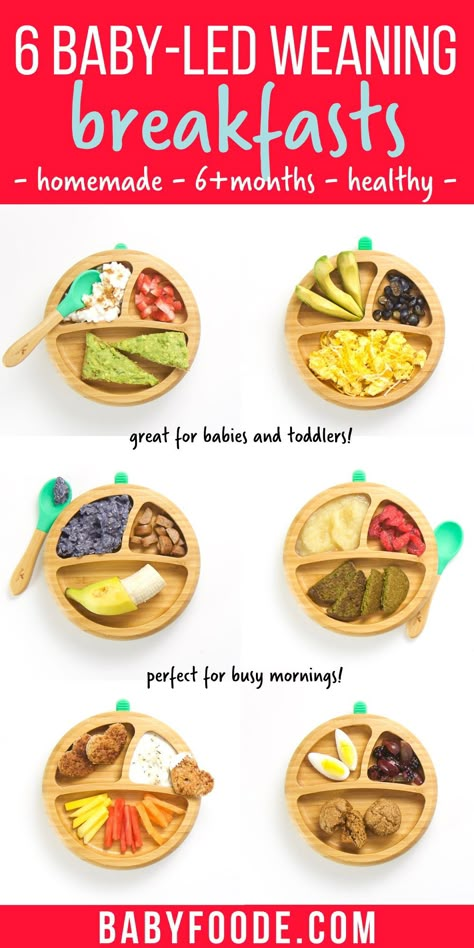 Plus: Learn why it’s perfectly okay to use a combined approach of blw and purees.
Plus: Learn why it’s perfectly okay to use a combined approach of blw and purees.
Baby Led Weaning
The feeding approach known as “baby led weaning” or “BLW” for short, is a style of feeding infants that allows them to feed themselves right from the start. The food is offered in thick finger-size pieces and is soft and easily squishable between your fingers. This way, the food is both easy to hold but has a low risk of choking.
TIP: This method became popular about a decade ago after the publication of the Baby Led Weaning: The Essential Guide to Introducing Solid Food by UK author Gill Rapley.
BLW Baby
One of the many reasons that people are starting to opt for this style of feeding more and more is simply that it’s easy. In many cases, you can modify foods you’re already making to share with your baby and there’s not always a lot of separate cooking involved. It also allows a baby to have control over what goes into their mouths, which sets a good precedent for letting them eat intuitively from the start.
What age should I start baby led weaning?
According to the American Academy of Pediatrics, a baby is ready to start solids with baby led weaning when:
- They’ve doubled their birth weight (at least).
- They can hold their head up well and are starting to sit up unsupported.
- They show signs of being interested in food (watching you eat, reaching for food when you’re eating, etc).
- When you feed them, they are able to move the food around in their mouths—rather than spit it right out.
TIP: Look for a highchair that allows a baby to sit up relatively straight so they can have good posture and better control over their arms and hands.
How to Start Baby Led Weaning
The first time you offer solids is such a fun milestone, so you’ll be ready once you follow these simple steps.
- Make sure baby has hit the milestones listed above to let you know that he’s ready to start.
- Get the highchair ready and adjust the straps and foot rest as needed.

- Plan to introduce water when you start solids. I recommend a trainer cup.
- Choose one food to start with and plan to offer only one food at a time.
- Stop when baby starts to fuss, turns his head away, or shows any other signs of not wanting to continue. It’s usually fairly obvious when they are done!
TIP: If you start offering solids and baby just doesn’t seem interested at all, it’s okay. Take a break for a few days or a few weeks and start again. Each kiddo has their own unique timeline.
Best Tips for Starting BLW
Here are a few more tips to consider and review before you get started.
- Understand the gag reflex. Gagging is different than choking though and is most often a sign that baby is learning to move food around in their mouths—and to get it out of their mouths, which is a skill you want them to have!
- Brush up on the basics of how to know when baby is ready to start solids. (Go back to the top of this post for the signs to look for.
 )
) - Set them up for success with a highchair that allows them to sit up straight and has foot support.
- Sit with them as you offer food.
- Check your own expectations of what will happen and simply allow your baby to take the lead.
- Start with one new food a day or every few days.
- Vary the textures of foods you offer to start exposing baby to many right from the start.
- Offer water in a sippy cup or small open cup.
TIP: Remember that breastmilk or formula will continue to satisfy baby’s hunger for the first few months of eating solids. Do not expect solids to replace milk feedings at this age.
First Foods for Baby
Starting solids with baby led weaning or purees are both perfectly acceptable ways to introduce a baby to solid foods—but the topic can get so heated! There’s a lot of pressure to do it the “right” way and I’m here to say that there isn’t one. You 100% can do one or the other, or combine the two to make it work for your family. It’s all good!
It’s all good!
Remember, the goal with first foods for baby is that they’re introduced to flavors, nutrients, and foods they can easily eat or suck on. It should be an enjoyable milestone for all involved.
TIP: It’s a good idea to get into the habit of offering an iron-rich food since iron stores in babies start to run out around 6 months and they’ll need to start ingesting it in their food.
Best First Foods for Baby Led Weaning
Here are some of our favorite first foods to offer baby led weaning style. You want foods to be finger sized so they are large enough that baby can’t force the whole piece into their mouth, and a shape that’s easy for a 6 month old to hold with their chubby little hands. These are some of our favorites.
- Roasted sweet potato wedges
- Roasted apple wedges, skin on to help them hold together
- Roasted or steamed broccoli florets (big enough for baby to hold)
- Melon slices
- Thick mango slice
- Banana with some of the peel still on
- Toast sticks with mashed avocado
- Avocado spears (make sure the avocado is ripe and soft)
- Lamb or beef, on the bone or a large piece for baby to suck on
- Dark meat chicken, on the bone or a large piece for baby to suck on.
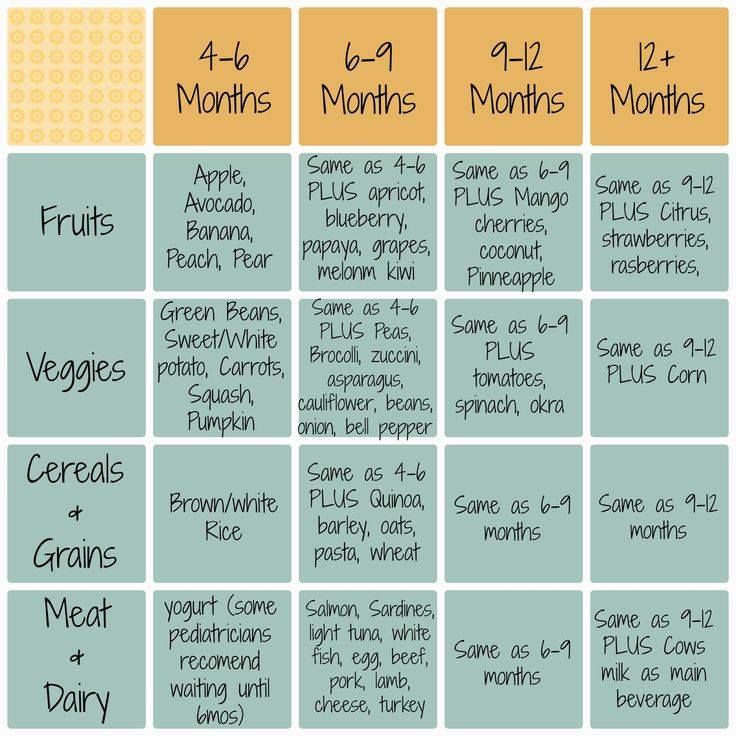
TIP: The foods should generally be soft enough to squish between your fingers with the exception of the large pieces of meat. If baby gnaws a piece down into a smaller piece, replace it with a larger one to avoid her putting a chunk of food into her mouth.
Baby Led Weaning Banana
To serve a banana to a baby, wash it well, then slice it in half. Cut off an inch or two of the peel, but leave the rest of the peel on so it’s not slippery for baby to hold. They’ll suck on the top part like a little popsicle! You can also help them hold the banana if needed.
Foods to Avoid Serving While Doing BLW
You want any foods you offer to a baby while doing baby led weaning to be soft enough to squish between your fingers and safe for them to eat and digest. Plan to avoid:
- Anything hard, sticky, or crunchy (like raw apple or carrot, whole nuts, crackers, or a big spoonful or nut butter)
- Added salt
- Cow’s milk (which is difficult for kids under 1 to digest; plain yogurt is fine though)
- Added sugar (they simply don’t need it)
- Honey (to avoid a risk of botulism)
- Super slippery foods that would be hard for baby to hold (which can be frustrating)
TIP: Always sit with your baby and watch them try to eat. They are your best guide for making adjustments to the foods you serve.
They are your best guide for making adjustments to the foods you serve.
Baby Led Weaning and Choking
There are many parents who dislike this method of feeding because it often sounds like a baby is choking. And while there are surely some incidences of choking, what’s more likely is that a baby will occasionally gag on a piece of food that gets into their mouth that they weren’t expecting.
But remember: Gagging is a sign that baby is doing what she needs to in order to move the food around in their mouth as they learn to eat. It usually sounds more dangerous than it actually is.
TIP: If the sound of gagging really freaks you out, you’re not alone. Consider offering more preloaded spoons with purees to start your journey more slowly.
How to Cut Foods for BLW
You generally want the food to be big enough that it would be difficult for baby to put the entire thing into their mouths. Here are some specifics:
- Foods that are roughly the size of a finger, so about a 4-inch stick.

- Foods that are easy for the baby to pick up—they can’t pick up small pieces until closer to 9 months when they develop the ability to use their fingers in what’s known as a “pincer grasp”.
- Foods that aren’t too slippery—so you can wash and leave some of the peel on fresh foods like bananas, avocado, kiwi, and mango.
TIP: You can also go even bigger if you’re worried about size. Think half of a slice of bread or a big chunk of watermelon.
Will my baby actually eat much food with BLW?
Probably not at first. There will likely be more tasting of the food than eating of it and that is totally fine. They will still rely on breast milk or formula at this age for their main nutrition, so don’t expect them to suddenly start eating full meals. (They’ll get there in a few months, but it takes time!)
Do babies need teeth for baby led weaning?
No! Gums are super strong and front teeth aren’t used for chewing—that happens when the back molars come in.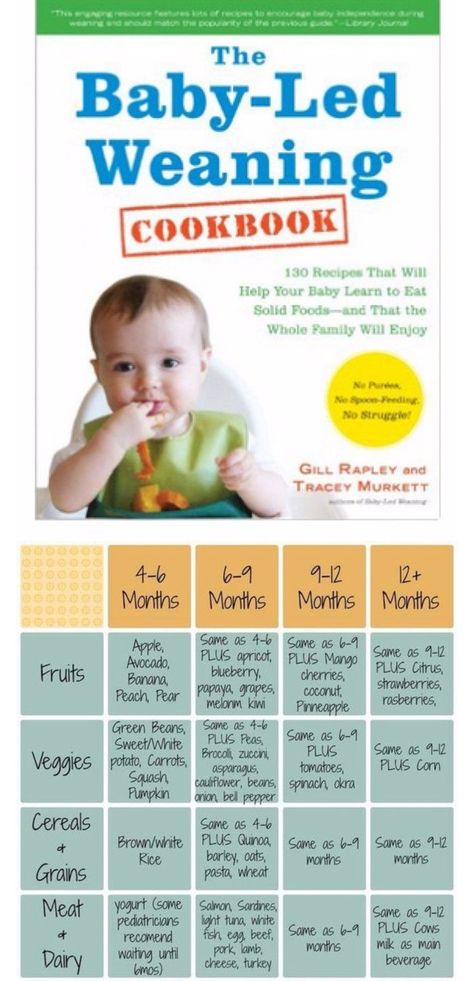 Teeth really have nothing to do with whether or not a baby can eat solids.
Teeth really have nothing to do with whether or not a baby can eat solids.
TIP: Learn more about what to expect from teething here.
Can you mix baby led weaning and purees?
Absolutely! I think it’s a great idea to mix the two methods simply because it gives you many more options for foods and allows the baby to experience more textures. I recommend allowing babies to feed themselves preloaded spoons—so you put the puree on a spoon, then hand it to them to actually put the spoon into their mouth—so they still have control over what goes into their mouths.
TIP: Feeding some purees is also helpful if you’ll be sending food with a baby to daycare since the care provider may not have experience with blw.
Best First Foods for Baby: Purees
Here are some of our favorite purees to start offering baby when they’re ready to start solids. Remember: There’s no evidence that says that you need to start with vegetables versus fruits, so go with something that tastes good to you. Start with single foods pureed smooth and offer just a little at a time on a spoon.
Start with single foods pureed smooth and offer just a little at a time on a spoon.
- Mashed roasted sweet potato puree
- Mashed avocado puree
- Mashed banana puree
- Butternut squash puree
- Applesauce, unsweetened
- Mashed pea puree
- Oatmeal baby cereal (with added iron)
TIP: One of my favorite baby food companies is Amara Organic Baby Food, a company using a nutrient protection technology that makes organic purees just as good as homemade. I love how easy they are to use when I need a shortcut and that they have fun baby-led weaning recipes on the side of every box! (paid affiliate link)
How do I know when baby has had enough?
If your baby is eating and then starts to turn her head away or just refuses to open her mouth, she’s done! Babies may also start to fuss if they’ve had enough. Learning this new skill takes time and babies can become tired fairly quickly into the process, so don’t expect them to always eat very much or to last very long at the table.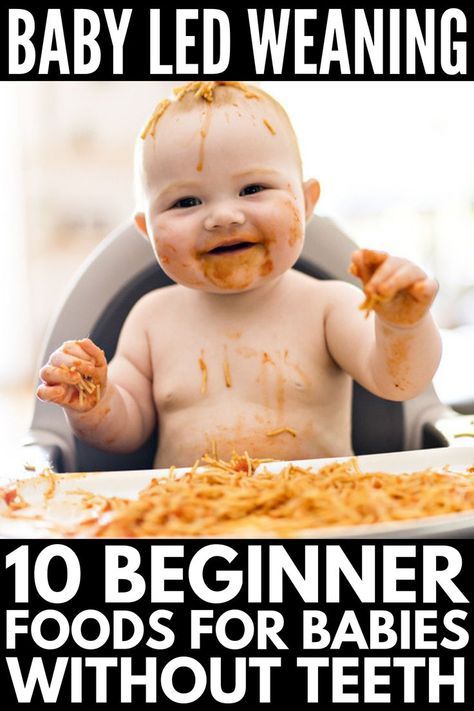 This stage is about exploration!
This stage is about exploration!
How to Let Baby Self Feed Purees
I love offering purees on a preloaded spoon. To do this, the parent, puts some of the food on the spoon and hands it to baby. Then baby can bring the food to their mouth all by themselves. This gives you some of the same advantages of baby led weaning, but can be more comfortable for many parents.
Remember, you can mix what you offer, going back and forth between purees and blw finger foods, so you can offer the same food two different ways to let baby explore. The main goal is to avoid forcing baby to take more bites than they want to, which can sometimes happen with purees.
Baby eating peanut butter toast stickWhen to Introduce Potentially Allergenic Foods
In recent years, guidelines have been updated on when to introduce potential allergens including peanuts, eggs, and shellfish, so unless you have a family history of a food allergy, you can go ahead and introduce them soon after baby starts eating solids. In fact, research is showing that introducing these foods early can actually protect baby from developing an allergy. Talk to your pediatrician if you have concerns.
In fact, research is showing that introducing these foods early can actually protect baby from developing an allergy. Talk to your pediatrician if you have concerns.
TIP: Thin unsweetened peanut butter with water to form a very thin Peanut Butter Puree until it’s about the consistency of regular yogurt and offer a very small amount on a spoon or spread on a toast stick.
What does a baby led weaning meal look like for months 7 and 8?
Until a baby is closer to 9 months and is able to pick up smaller pieces of foods, but after they have gotten the hang of one food at a time, I try to offer 1-2 foods they can feed themselves and one puree. This offers them a chance to ingest more via the puree but still feed themselves a range of textures. You can do more or less food following the lead of the child.
TIP: My Baby Food Chart has loads of with ideas for blw foods and purees by month.
Recipes for Every Stage of Starting Solids
If you’re ready to start solids with baby, or you’re just curious what it looks like to do a mix of baby led weaning and purees, check out my Yummy Baby Food cookbook. It goes stage by stage with specific foods to start in each, with simple recipes and easy feeding tips.
It goes stage by stage with specific foods to start in each, with simple recipes and easy feeding tips.
Listen to a recent podcast episode to hear about some of the basics of BLW with our guest Megan McNamee, MPH, RDN, CLT, and a Registered Dietitian Nutritionist specializing in pediatric nutrition who runs Feeding Littles.
I’d love to hear any questions you have with BLW or if your baby had a first food that I didn’t list here. Please comment below to share your experience!
Prep Time 5 minutes
Total Time 5 minutes
Author Amy Palanjian
Cuisine American
Course Dinner
Calories 28kcal
Servings 1
Banana
- ▢ 1 small ripe banana with peel on
Roasted Sweet Potato
- ▢ 1 small sweet potato + 1 teaspoon olive oil
Roasted Apple
- ▢ 1 small apple + 1 teaspoon butter or neutral oil
Roasted Broccoli
- ▢ 1 cup broccoli florets + 1 teaspoon olive oil
Sauteed Green Beans
- ▢ 4 green beans 1 teaspoon olive oil
Melon
- ▢ 1 small piece watermelon or cantaloupe
Avocado Toast
- ▢ 1 slice whole grain bread
- ▢ 1 tbsp ripe avocado
Avocado Spear
- ▢ ⅛ ripe avocado
Lamb or Beef
- ▢ 1 lamb chop, roast, or steak
Pan-Seared Chicken Thighs
- ▢ 1 chicken thigh
- ▢ 1 tsp olive oil
- ▢ 1 garlic clove, optional
Banana with some of the peel still on
Cut a banana in half.
 Use a knife to gently cut around the peel about 2 inches down, leaving some of the peel on so that the banana is easy for baby to hold and less slippery.
Use a knife to gently cut around the peel about 2 inches down, leaving some of the peel on so that the banana is easy for baby to hold and less slippery.
Roasted Sweet Potato Wedges
Preheat oven to 400 degrees and line a rimmed baking sheet with foil. Wash and dry the sweet potato. (You don't need to peel it.) Cut in half, then cut lengthwise into strips. Cut each strip in half again until each is about 1/2-inch thick. Slice in half horizontally if the sweet potato is very long. (Each strip should be about the size of your finger.) Place into a bowl and toss with the olive oil. Spread onto prepared baking sheet and roast for 22-25 minutes or until soft. Let cool slightly and serve.
Roasted Apple Wedges
Roasted Broccoli Florets
Preheat the oven to 400 degrees F. Place the broccoli onto a rimmed baking sheet and toss with the olive oil, coating and mixing well until all of the florets are a little shiny and coated with oil.
 Roast for 15-18 minutes or until tender. Let cool slightly and serve.
Roast for 15-18 minutes or until tender. Let cool slightly and serve.
Sauteed Green Beans
Warm the oil in a large skillet over medium heat. Add the green beans and stir. Cover and cook for about 8 minutes. Remove cover and taste one to see if it’s soft enough. Cook for an additional minute or two as needed.
Melon slices
Avocado Toast
Avocado Spears
(Make sure the avocado is ripe and soft): Cut a thick strip of avocado and offer to baby. You can leave the peel on if that makes it easier for baby to hold (just wash it first).
Lamb or Beef
Prepare a roast, steak, or chop without salt and with butter or olive oil until cooked medium well. Offer a thick slice at least the size of your finger or a drumstick.
Pan-Seared Chicken Thighs
Warm 1 tablespoon olive oil or butter in a large skillet over medium heat. Add the chicken thigh and top with a few slices of fresh garlic, if desired.
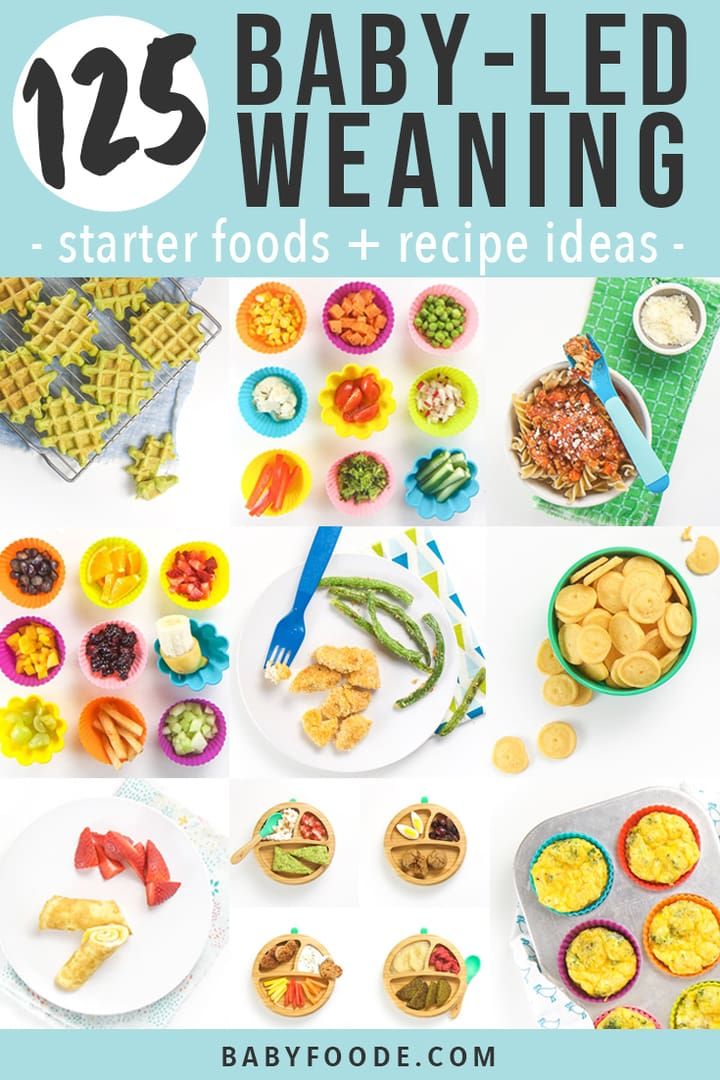 Cover and cook for 4-5 minutes. Remove cover. Flip over and cook for an additional 4-5 minutes uncovered or until a meat thermometer registers 165 degrees F.
Cover and cook for 4-5 minutes. Remove cover. Flip over and cook for an additional 4-5 minutes uncovered or until a meat thermometer registers 165 degrees F.
- Add spices like garlic powder, cinnamon, cumin, oregano, or any other non-spicy flavor you like to make these more interesting.
- Offer just one piece at a time when starting out.
- If baby gnaws a piece down into a smaller piece, replace it with a larger one to avoid her putting a chunk of food into her mouth.
- Store any leftovers in an airtight container in the fridge for 3-5 days. Reheat briefly if needed.
- Remember that it's normal for babies to take time to actually ingest the food. Part of the process is exploring all of the senses related to the experience of eating.
Calories: 28kcal, Carbohydrates: 2g, Protein: 1g, Fat: 2g, Saturated Fat: 1g, Polyunsaturated Fat: 1g, Monounsaturated Fat: 2g, Sodium: 6mg, Potassium: 75mg, Fiber: 1g, Sugar: 1g, Vitamin A: 23IU, Vitamin C: 2mg, Calcium: 2mg, Iron: 1mg
Tried this recipe?Rate in the comments and tag @yummytoddlerfood on IG!
Manufacturers have warned of a possible increase in prices for baby food - Agroinvestor
The baby food industry is not experiencing problems associated with a high level of counterfeiting A.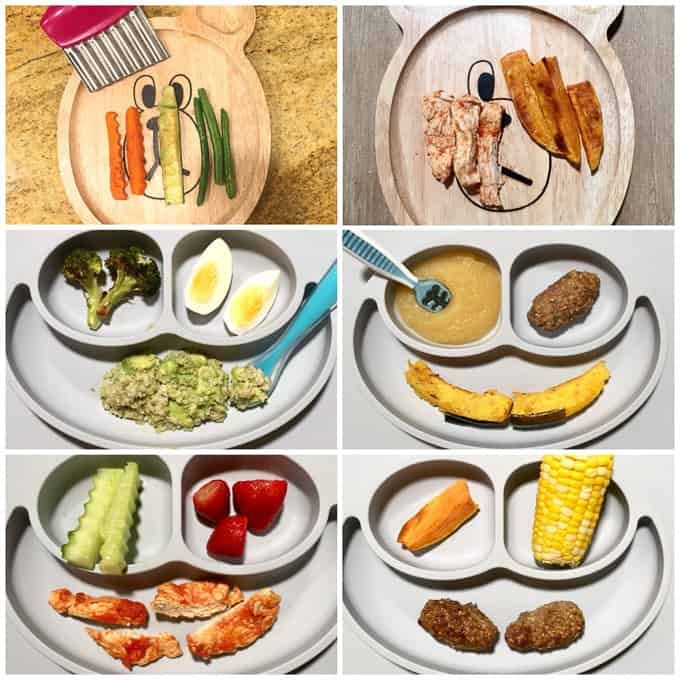 Gordeev
Gordeev The business proposes to exclude products for children from the labeling experiment for canned meats, vegetables and fruits. This follows from a letter from the association of manufacturers "Rusbrand" (includes Nestle, Danone, etc.) to the Ministry of Economic Development, which Izvestia has read. The letter notes that for foreign products, the developer offered more expensive technical solutions, which threatens with a shortage of goods on the shelf and an increase in prices "by at least 10%".
The level of imports in this segment is 25-30%, Rusbrand estimates. Also, the association does not understand what problem labeling will solve, because there are no known cases of counterfeiting in the industry recorded by regulators: the industry has established state control over the production, distribution and sale of baby food, increased requirements are imposed on raw materials and materials, and the finished product is packaged in sealed packaging, which undergoes sterilization.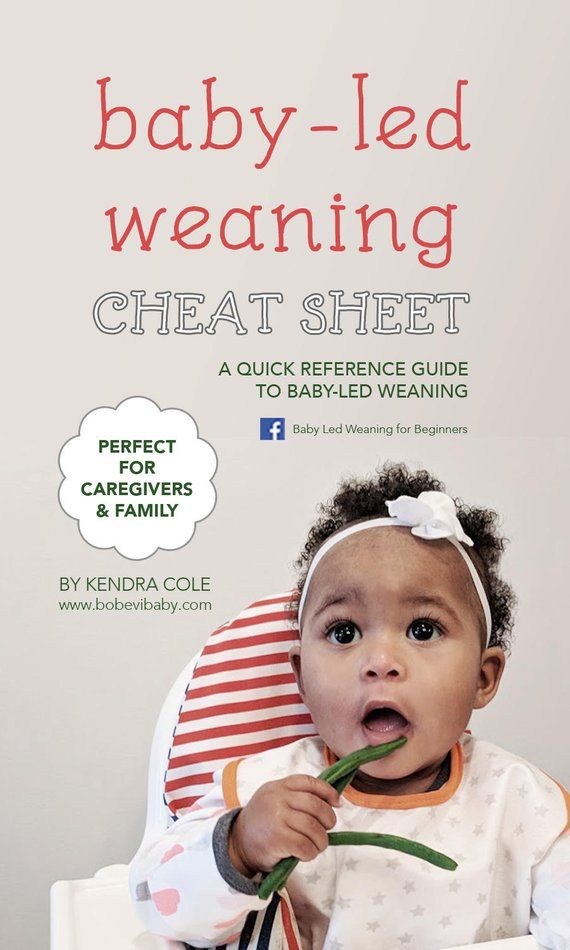
The Ministry of Industry and Trade proposes to conduct an experiment on labeling canned food for children from vegetables and meat, as well as jams, jellies and nut butters from May 1, 2022 to February 28, 2023. The draft government decree on the experiment was prepared on behalf of the president. An objective assessment of the costs of introducing marking is possible only during the experiment; support measures have been developed for the companies participating in it, including soft loans for the purchase of marking equipment, says a representative of the department.
Chairman of the Board of the Dairy Union of Russia Lyudmila Manitskaya told Agroinvestor that baby food is not getting more expensive because of labeling. “Prices in this segment will increase for the same reason as for other products: the cost of all components of production is growing. We are talking about fuel, electricity, imported components and so on. In addition, inflation is rising, and the ruble is weakening, ”commented Manitskaya. According to her, falsified products are periodically found in the baby food segment. “Full-fledged labeling for baby food has not yet been introduced, so we do not yet understand how it will work and how it will protect the buyer,” added Manitskaya.
According to her, falsified products are periodically found in the baby food segment. “Full-fledged labeling for baby food has not yet been introduced, so we do not yet understand how it will work and how it will protect the buyer,” added Manitskaya.
Dmitry Leonov, Deputy Chairman of the Board of Rusprodsoyuz, is sure that labeling will invariably lead to an increase in prices on the shelf. According to the most modest forecasts, the growth per unit of goods will be from 10%, he believes. “In a situation of rising prices for all components of the cost of production - raw materials, logistics, packaging - and the ongoing trend of falling incomes of the population, the introduction of an additional financial burden on both business and consumers is unacceptable. According to dairy producers, where labeling has already been introduced, it has become one of the most expensive regulatory measures in the history of the sector,” Leonov told Agroinvestor.
In his opinion, the introduction of mandatory labeling for certain categories must be approached "extremely balanced and cautious.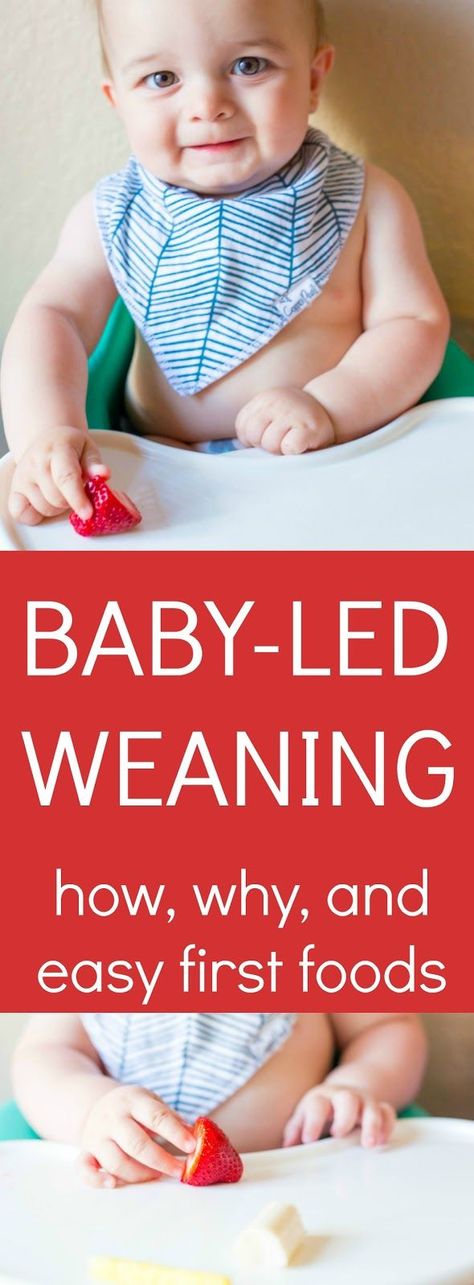 " It is worth starting with independent research of the counterfeit market in these categories and discussion with the business community of all the risks and expediency of labeling. The total introduction of labeling without objective indicators of a high level of counterfeiting in a category is fraught with a significant increase in prices for many groups of goods, Leonov warns.
" It is worth starting with independent research of the counterfeit market in these categories and discussion with the business community of all the risks and expediency of labeling. The total introduction of labeling without objective indicators of a high level of counterfeiting in a category is fraught with a significant increase in prices for many groups of goods, Leonov warns.
The baby food industry is not experiencing problems with high levels of counterfeiting, he continues, adding that these may be isolated cases. This is due to rather strict state control over the production and sale of baby food at all levels "from the field / farm to the counter." “Increased requirements are imposed on raw materials, equipment and materials that are used for the preparation of children's preservation. In addition, products for children do not go through a simplified procedure for declaring safety, but a strict certification system,” Leonov emphasizes.
CRPT specialists are confident that information about the impact of labeling on the cost of baby food "does not correspond to reality and is not supported by calculations.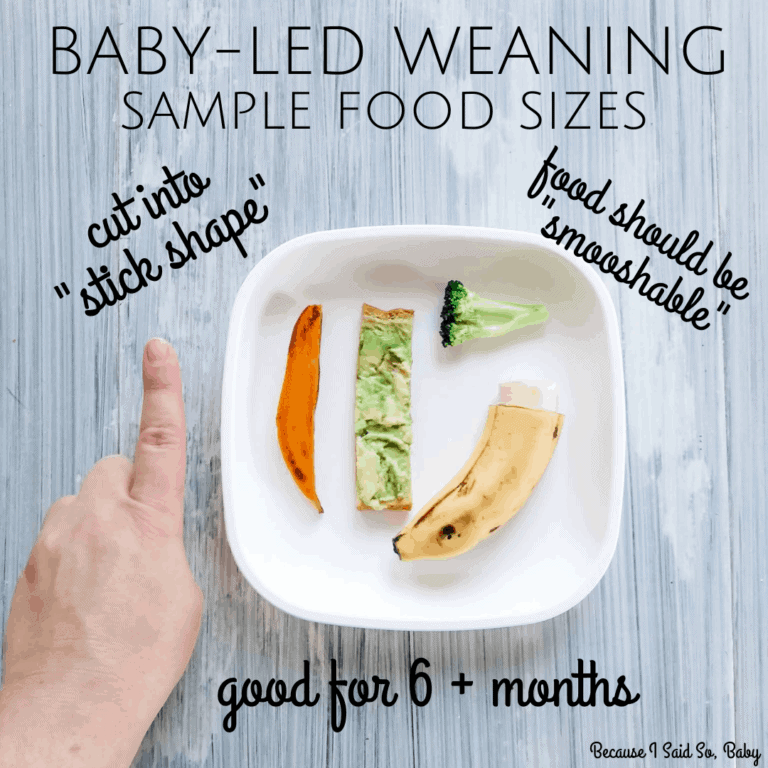 " “Having looked at the price dynamics in those industries for which labeling has already become mandatory, we can make an unambiguous conclusion that in none of the industries, labeling has led to price increases that buyers could notice,” said Revaz Yusupov, Deputy General Director of the Advanced Technologies Development Center. (quote from the center). “We are convinced that in this industry, too, all these apocalyptic forecasts will remain nothing more than forecasts.”
" “Having looked at the price dynamics in those industries for which labeling has already become mandatory, we can make an unambiguous conclusion that in none of the industries, labeling has led to price increases that buyers could notice,” said Revaz Yusupov, Deputy General Director of the Advanced Technologies Development Center. (quote from the center). “We are convinced that in this industry, too, all these apocalyptic forecasts will remain nothing more than forecasts.”
what kind of food is possible, features of complementary foods
It is no secret that young and not very experienced mothers receive information on the nutrition of an infant, including recommendations on how to introduce the first complementary foods, mainly from two sources: grandmother's stories and from the Internet. Unfortunately, both of these respected sources of information may voluntarily or not voluntarily, but be very mistaken, since grandmothers grew up in a more prosperous time in terms of environmental conditions, and the Internet is littered with various articles that are rarely written by professionals, moreover, they rely either on explicit outdated guides on baby food, or frankly on unverified information.
In this article, I will try to combine the latest scientific data and recommendations on how to introduce the first complementary foods with many years of observations from the experience of a practical pediatrician and an allergist-immunologist.
At what age is it time to introduce the first complementary foods
According to the recommendations of the Research Institute of Nutrition of the Russian Academy of Medical Sciences, the first complementary foods can be introduced from 4.5 - 5 months, regardless of the type of feeding. This is "average". In practice, the choice of when to start introducing complementary foods still depends on the individual characteristics of the child. For example, for a child with widespread atopic dermatitis (diathesis), we will not introduce complementary foods until at least acute skin symptoms, such as cracks, weeping or secondary eczema, have steadily disappeared. Increased dryness and flaking of the skin, of course, require constant application of moisturizers to the skin, but in no case are they a contraindication to the start of the introduction of the first complementary foods.
Another important point when choosing the time to start introducing complementary foods is the dynamics of the child's weight gain. The more intensively the child gains in height and weight, the sooner he may need additional calories, since the energy value of breast milk or artificial formula alone will most likely not be enough for a child who grows faster than his peers by 4 - 5 months. We must not forget that natural products contain a fairly large range of minerals and vitamins, and a mother’s body, alas, cannot be an eternal and bottomless source of useful nutrients, somewhere something will gradually begin to be missed.
In addition, the nature of lactation in the mother has a great influence on the timing of the introduction of complementary foods. If a nursing mother begins to feel a lack of milk, I would prefer to first give her advice on stimulating lactation, and at the same time begin to introduce complementary foods. It will be better than introducing an artificial mixture. But I repeat that the earliest start date for the introduction of the first complementary foods is the age of 4 months, before the child's body is not yet ready, the risk of developing allergies is also high.
But I repeat that the earliest start date for the introduction of the first complementary foods is the age of 4 months, before the child's body is not yet ready, the risk of developing allergies is also high.
So, we agree with you that the first complementary foods can be introduced no earlier than 4 months of a child's life.
First complementary foods: Which foods to choose?
The first complementary foods, as a rule, should consist of vegetable or fruit purees, but in no case juices. Still, juices, even for children, are highly filtered, mainly contain a large amount of organic acids and “light” carbohydrates (that is, sugar, to make it clear to everyone). I will not waste time explaining why juices are harmful to an infant, but I will describe a clinical case from practice.
Parents with an 8-month-old girl came to the reception. Somewhere from 5 months she practically did not gain weight, although before that all indicators were normal. In the analyzes, apart from visible signs of iron deficiency, slightly reduced hemoglobin, no pathology was also detected. The main complaint: "does not eat anything." And when I began to find out what she still eats, it turned out that the child drinks half a liter of juice every day. But porridge or cottage cheese, or mashed potatoes cannot be forced together, they spit everything out. I don't like the taste. And so - for three months. The child, of course, became very nervous, yelling at night, demanding juice.
The main complaint: "does not eat anything." And when I began to find out what she still eats, it turned out that the child drinks half a liter of juice every day. But porridge or cottage cheese, or mashed potatoes cannot be forced together, they spit everything out. I don't like the taste. And so - for three months. The child, of course, became very nervous, yelling at night, demanding juice.
So draw your own conclusions and be careful.
For the first feeding, this is now recognized by everyone, the best dishes are vegetable purees from green varieties of vegetables: zucchini, cauliflower, broccoli. The first complementary foods are introduced, starting with half a teaspoon, in the morning for three days, then gradually increase the amount of the product to 40-50 grams per week. Supplemented with breast milk or formula.
For problems with stools, constipation, it’s good to start introducing prune puree, green apple, you can try pumpkin, even apricot puree, but in no case start with carrots.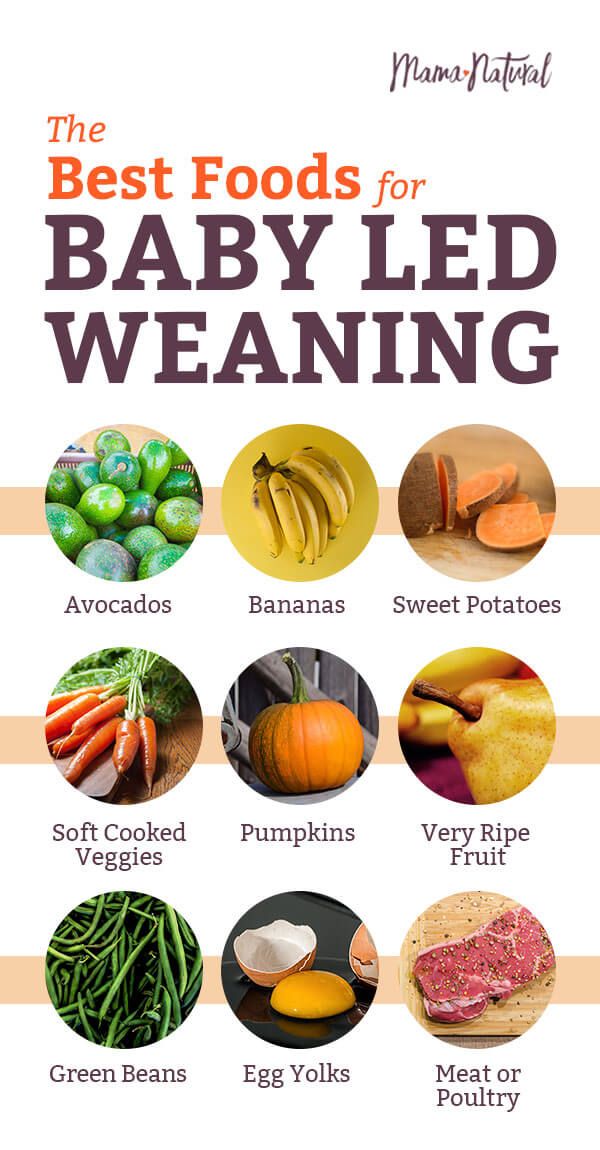 Beta-carotenoids, which are abundant in carrots, are generally poorly absorbed and can cause allergies in a child.
Beta-carotenoids, which are abundant in carrots, are generally poorly absorbed and can cause allergies in a child.
Second food. Porridge or meat?
Even 5 - 6 years ago, we taught students at the medical institute that from 5 - 5.5 months old, an infant should begin to give cereal porridge for complementary foods. This is rice, buckwheat, corn. The first week you can cook 5% porridge: 5 grams of ground cereal per 100 ml of water. Then the porridges are cooked already denser: 10 grams of cereal per 100 ml of water. But now, basically everyone uses instant (soluble) cereals, which are diluted with water according to the instructions on the package. In addition, ready-to-eat liquid cereals are on sale: for example, Bellakt, Frutonyanya, etc.
Why meat? You ask. According to modern recommendations (they really began to change quite often), but in this case I support: if a child has a pronounced decrease in hemoglobin in the blood below 100 g / l by the age of 5 months, it makes sense to start introducing fruit or vegetable purees as a second types of complementary foods - meat purees as a source of the most well-absorbed heme iron.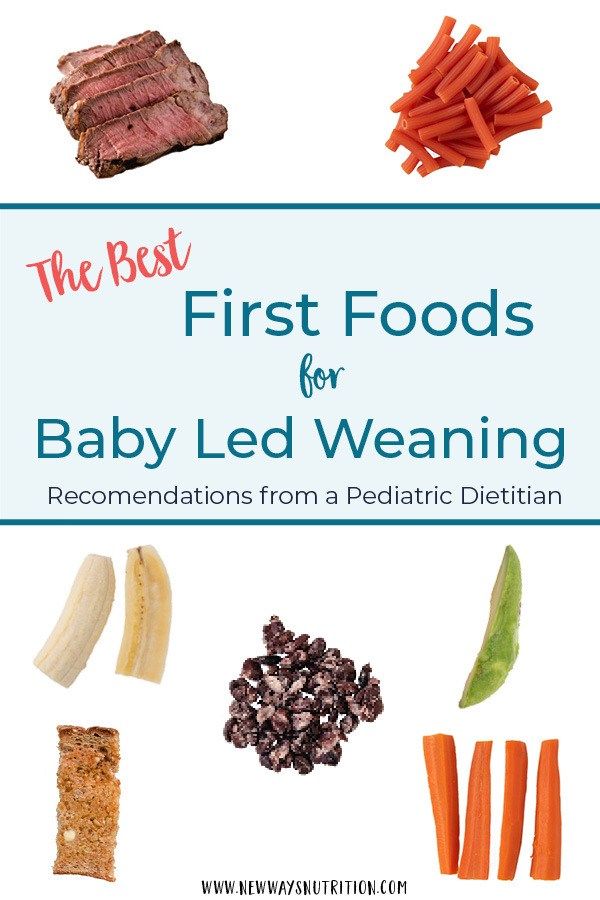 You need to choose from varieties such as turkey, rabbit, lamb. Beef and veal can only be offered to children who did not have red cheeks and diathesis.
You need to choose from varieties such as turkey, rabbit, lamb. Beef and veal can only be offered to children who did not have red cheeks and diathesis.
In the absence of problems with low hemoglobin, feel free to introduce porridge as the second meal of complementary foods, especially if the child is small and does not gain weight very well. In this case, we can recommend breeding cereals with the addition of breast milk or a mixture (Nan, Nutrilon, Celia, Nanny). With mixtures based on goat's milk, parents of children with a predisposition to allergies should be very careful. Goat milk formulas are not the best choice for babies who are allergic or intolerant to cow's milk protein, whatever the internet says. Believe me, there are serious scientific articles by foreign authors, which provided data on a very high frequency of cross-allergy between cow and goat milk proteins in children who were transferred to goat milk mixtures. And I saw it myself in my practice, when a child with dermatitis was transferred to a mixture of goat's milk, there was a clear improvement for a month or two, and then all over again and with a doubled degree of allergic skin damage.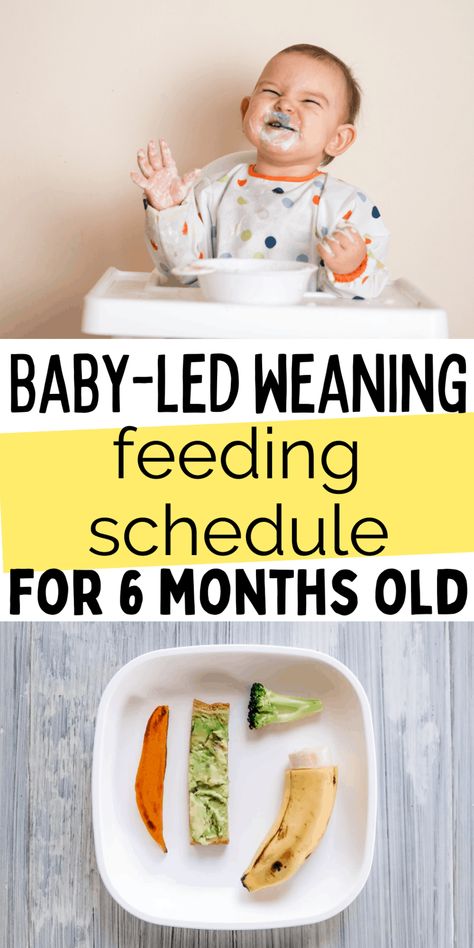
Introduction to fermented milk products
This is the most difficult question. I am sure that most of our grandparents demand that their stupid parents start drinking milk and kefir as soon as possible. In a number of cases, children really start to absorb sour-milk products quite well after 6 months, but before this age I am very careful even with sour-milk Agusha, and even introducing milk or kefir before 6 months is a bad form, believe me, and can lead to very bad consequences for the child. I understand the Western European medical community, which has recently banned its pediatricians from recommending fermented milk products for complementary foods for children under 3 years of age, just imagine!
They (the Europeans) need to do something with their artificial milk mixtures. Even 20 years ago, we did not know other mixtures after the "two", that is, the second formula for children from 6 to 12 months. Then there were formulas for children from 1 to 2 years old, then from 2 to 3 years old, and now there are already mixtures for children up to 4 years old, and I think if this goes on, then until the age of sixteen there will be their own milk substitutes. Dismiss me, I don't think this approach is correct. But the fact is that our grandparents had much better genetics than the generation of our children, alas. In the context of the growth of medical capabilities, genetically determined diseases are also growing, and in this case, intolerance to cow's milk protein, and with every 10 years there are more and more such people among us. But if a child really suffers from an allergy to cow's milk protein or is severely deficient in enzymes, then he will carry this peculiarity through his whole life, and most likely he will not drink milk or kefir himself, and there is no need to force him if he himself won't want to!
Dismiss me, I don't think this approach is correct. But the fact is that our grandparents had much better genetics than the generation of our children, alas. In the context of the growth of medical capabilities, genetically determined diseases are also growing, and in this case, intolerance to cow's milk protein, and with every 10 years there are more and more such people among us. But if a child really suffers from an allergy to cow's milk protein or is severely deficient in enzymes, then he will carry this peculiarity through his whole life, and most likely he will not drink milk or kefir himself, and there is no need to force him if he himself won't want to!
But you are lucky with genetics, and no one in the family has ever had an allergy (which is hard to imagine nowadays), and most importantly, if your child has always had perfectly clean skin, then the first of the dairy products - cottage cheese, you will begin to offer your child with 7 months, kefir - from 10 months.